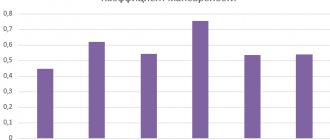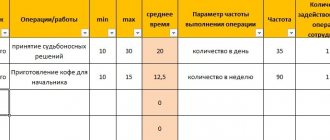What will the critical liquidity ratio show?
Like any other liquidity indicator, critical liquidity ratio , which can also be called the quick (or quick) liquidity ratio, reflects the level of ability of a legal entity’s assets to cover its liabilities.
The ratio under consideration will show to what extent the enterprise’s quickly realizable (highly liquid) assets will cover its current (short-term) debts, i.e. what part of liabilities with a maturity of less than 1 year can be paid in the shortest possible time using available assets.
Read about other important indicators for understanding the economic situation of an enterprise in the article “Basic financial ratios and formulas for their calculation .
CCL value
Due to the fact that quick-selling assets are used in the calculation of the critical liquidity indicator, it has another name - the quick liquidity indicator.
In order to analyze the financial condition of a company, having a calculated CCL, you need to know the acceptable values of the indicators. Analysts in Western countries believe that the standard value of quick liquidity should be 1.
Conclusions about this normal ratio are made on the basis of maintaining a balance between loans and deposits. In other words, a unit shows that the organization maintains a clear balance between debts and assets and can, in a critical situation, pay off all its debts with the help of highly liquid funds.
If the CCL level is low, company management should take the following steps:
- increase accounts receivable;
- reduce budgets for basic expenses;
- issue new shares or bonds;
- introduce incentives for buyers for timely payment of goods and introduce sanctions for late payments;
- minimize the attraction of borrowed capital;
- draw up a plan for reforming the financial budget.
Practice shows that most businessmen prefer to have a low indicator of quick liquidity and live in debt. This practice allows you to accumulate your own money and at the same time invest in promising production areas.
According to statistical research, most large companies try not to bring the liquidity ratio to one and leave it at the level of 0.5-0.8.
https://youtu.be/1TpKmm1HYJ8
How to improve the coefficient value
An increase in the value will be caused by an increase in the values reflected in the numerator of the formula (i.e., money, financial investments, customer debts), and a decrease in the values that make up its denominator (i.e., own short-term debts).
One way could be to draw up long-term rather than short-term credit (loan) agreements. You can find more complete information on the topic in ConsultantPlus. Full and free access to the system for 2 days.
Calculation example
The simplest example of solving the problem of calculating the quick liquidity ratio can be shown based on the following data:
| Balance | 2010, thousand rubles | 2011, thousand rubles | 2012, thousand rubles |
| Financial resources | 34 503 | 41 023 | 43 185 |
| Investments in promising instruments | 53 931 | 49 128 | 43 105 |
| Short-term receivables | 21 534 | 32 156 | 46 492 |
| Sum of all highly liquid assets | 109 968 | 122 307 | 132 782 |
| Debts with short maturities | 149 436 | 130 123 | 134 568 |
Calculating the QCL based on the above data will give the following results:
KKL2010 = A1 + A2 / P1 = 34,503 + 53,931 + 21,534 / 149,436 = 0.74
KKL2011 = A1 + A2 / P1 = 41,023 + 49,128 + 32,156 / 130,123 = 0.94
KKL2012 = A1 + A2 / P1 = 43,185 + 43,105 + 46,492 / 143,568 = 0.99
From calculating the CCL for three years of operation of the enterprise, several conclusions can be drawn:
- The financial department spends funds wisely and brings the enterprise to maximum liquidity.
- The dynamics of changes in CCL shows that in the future the company will be able to pay off all loans at once.
- The CCL for 2012 is 0.99, which guarantees almost complete reliability of the company.
It is worth noting that the definition of CCL is not a complete analysis of the company’s liquidity. In order to fully determine the level of solvency of an organization, it is necessary to conduct a comprehensive analysis of assets and liabilities, and only then draw final conclusions.
https://youtu.be/CK-tdSpTwq4
Definition and Formula in Excel
Absolute liquidity shows the short-term solvency of the organization: whether the company is able to pay off its obligations (with counterparties-suppliers) using the most liquid assets (cash and cash equivalents). The ratio is calculated as the ratio of financial assets to current liabilities.
The standard calculation formula looks like this:
Cubs. = (cash + short-term cash investments) / current liabilities
or like this:
Cubs. = highly liquid assets / (most urgent liabilities + medium-term liabilities)
The data for calculating the indicator is taken from the balance sheet. Let's look at an example in Excel.
We have circled the lines that are needed to calculate the absolute liquidity ratio. Balance formula:
Cubs. = (p. 1240 + p.
Who will benefit from the coefficient?
The critical liquidity indicator is primarily of interest to credit institutions. Before providing money to a company, bank employees conduct a full audit and determine the level of solvency of the organization. Such a step is quite logical, because no one would want to borrow money from a obviously insolvent enterprise.
Of course, the company employees themselves should also analyze the CCL. Regular research into the effectiveness of an organization's budget can significantly reduce the costs of applying and finding quick solutions to increase the ratio.
Fast and absolute liquidity
12345678910Next ⇒
Equity
The ratio of the main elements of capital of CJSC MPZ on the last day of the analyzed period (December 31, 2012) (own, long-term and short-term debt) is clearly presented in the diagram:
The organization's own capital as of December 31, 2012 is equal to XXX XXX thousand rubles, or XX% of the total capital.
The minimum acceptable share of equity capital depends on the structure of the organization’s assets, the ratio of non-current and current assets. The higher the share of non-current assets, the more machinery, equipment, and premises are needed for the operation (i.e., the more capital-intensive production), the greater the share of equity capital should be. Considering the asset structure typical for the “Production of Machinery and Equipment” industry, the normal share of equity capital is at least XX% (preferably XX%). For ZAO MPZ, the optimal share of equity capital, calculated according to the balance sheet as of December 31, 2012, is XX%, the minimum is XX%. Given the current structure of the organization's assets, it is these percentages that should be focused on when making financial decisions.
Explanation: The optimal share of equity capital was obtained in such a way that the equity ratio (approved by order of the Federal Department of Insolvency (Bankruptcy) dated September 12, 1994 N 56-r) corresponds to the norm, but not less than XX% of the total capital . The minimum recommended share is the percentage at which equity capital covers 90% of the book value of non-current assets, but not less than XX% of total capital. In addition to the optimal and minimum share of equity capital, there is a limit beyond which the share of equity capital is considered excessive, hindering the development of the company. As a general rule, this maximum share of equity capital is 70% (for enterprises in capital-intensive industries, the limit may be higher). Exceeding this limit indicates not only high financial independence, but also an unused opportunity to attract borrowed funds to increase the return on capital invested by the owners.
Now the share of the organization’s equity capital is XX%, which is X% less than the minimum acceptable value.
How to increase your net worth? The main source of growth in a company's equity capital is net profit. In addition, it is possible to increase the organization’s equity capital as a result of the following operations:
a) Revaluation of fixed assets in the direction of increasing their book (residual) value. A commercial organization may revalue groups of similar fixed assets at current (replacement) cost no more than once a year (at the end of the reporting year). When making a decision on revaluation of such fixed assets, it should be taken into account that in the future they are revalued regularly. Also note that an increase in the residual value of fixed assets leads to an increase in corporate property tax, but is not included in the income tax base.
b) Increase in authorized capital.
c) Contribution of the founders to the property of the company (without changing the authorized capital). This option does not imply a return on the invested funds, unlike a credit or loan. According to paragraphs. 3.4 clause 1 art. 251 of the Tax Code of the Russian Federation, funds contributed by a participant or shareholder to increase net assets are not subject to income tax. It is better to use money rather than property as a contribution, so that the transferring party (if it is an organization and not an individual) does not have a VAT base on the gratuitous transfer of property.
A certain lack of equity capital in this case is accompanied by a reduced current liquidity of assets.
Current liquidity
The structure of an organization's assets and liabilities, that is, its balance sheet, largely determines its solvency. Investors assess solvency based on the liquidity of current assets, which is determined by the time required to convert them into cash. In this part, indicators of the quality of the structure of assets and liabilities are liquidity ratios. Let's consider the structure of the balance sheet of ZAO MPZ from the point of view of liquidity indicators.
First, consider the current ratio, which shows the ratio of current assets and short-term liabilities.
| Current ratio | = | Current assets | = | X,XX |
| Short-term liabilities |
The current liquidity ratio as of December 31, 2012 is X.XX. This is below the generally accepted norm; the organization does not have enough liquid (current) assets in comparison with the existing amount of short-term liabilities. The normal value in Russian practice is the value of the current liquidity ratio XX.X. We recommend increasing the level of current liquidity.
There are two ways to increase the current liquidity of an organization:
a) Reduce the amount of short-term liabilities (in this case by XX XXX thousand rubles). You can reduce short-term liabilities by transferring part of them into long-term liabilities, i.e. attracting loans and borrowings on a long-term basis.
b) Increase the amount of current assets by reducing the amount of non-current assets. For example, through the sale of unnecessary, non-core, unused fixed assets.
In addition, the liquidity (solvency) of an organization can be increased by accelerating asset turnover. Asset turnover largely depends on the production cycle. Shortening the cycle allows less liquid assets (inventories) to quickly turn into highly liquid assets (accounts receivable, cash). This increases the organization's ability to pay its obligations. It is possible to increase turnover not only by accelerating the production process itself (or the process of performing work and providing services), but also by tightening the payment discipline of buyers and reducing the period for collecting receivables. During the period under review, the organization’s receivables turnover was 51 days (this is the average estimated number of days that elapse from the moment the customer debt arises until the moment it is repaid).
Fast and absolute liquidity
The current ratio is the most general indicator of asset liquidity. To check solvency for a shorter period, the quick liquidity ratio and the absolute liquidity ratio .
The quick ratio shows the sufficiency of liquid assets (short-term receivables, financial investments and cash) in comparison with short-term liabilities. That is, if the current liquidity ratio was calculated using all current assets, then the least liquid ones - inventories - are excluded from them.
| Quick ratio | = | (Short-term accounts receivable + Short-term financial investments + Cash) |
| Short-term liabilities |
Unlike the quick liquidity ratio, the absolute liquidity ratio measures the sufficiency of the most liquid assets - short-term financial investments and cash.
| Absolute liquidity ratio | = | (Short-term financial investments + Cash) |
| Short-term liabilities |
Indicators of quick and absolute liquidity are designed to signal the risk of loss of solvency already in the short term. Having a sufficient balance of funds is a necessary condition for the normal conduct of current settlements with suppliers and contractors, personnel, and the budget.
| Liquidity ratio | The value of the indicator for ZAO MPZ as of December 31, 2012 | Recommended (normal) value, not less | For the coefficient to take on a normal value, CJSC MPZ needs |
| reduce short-term liabilities by, thousand rubles. |











